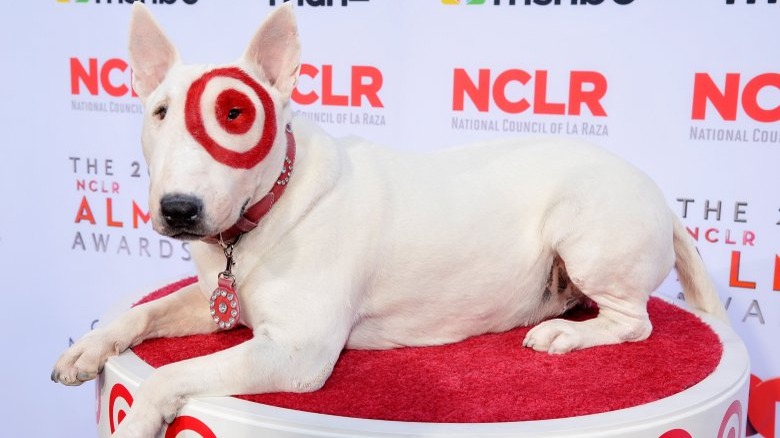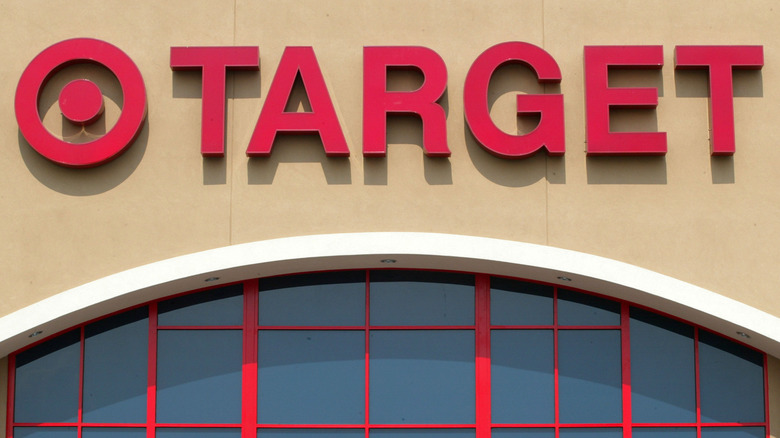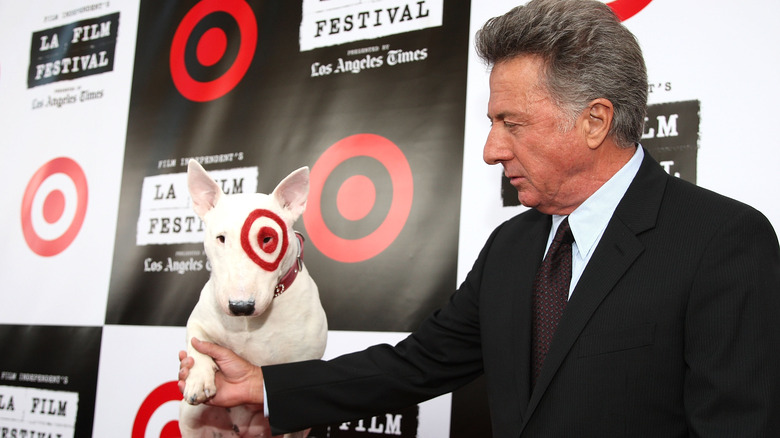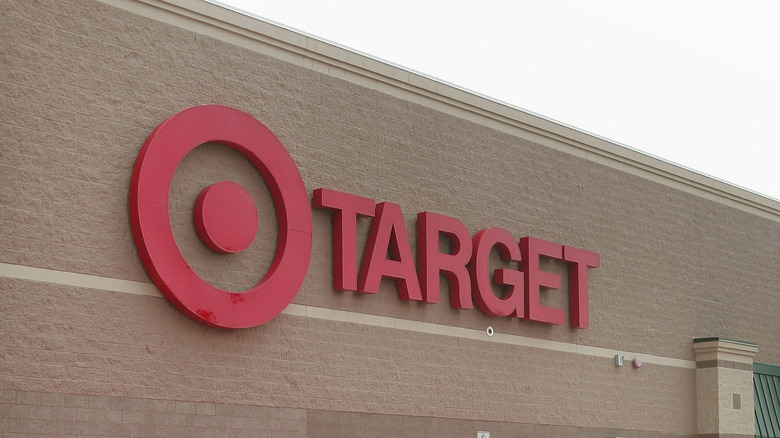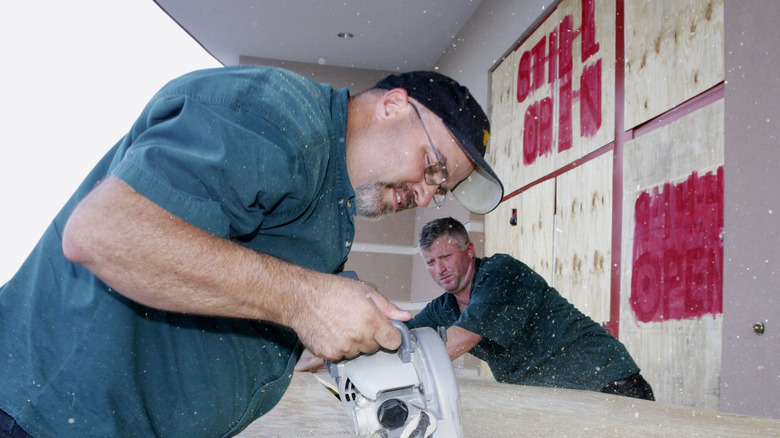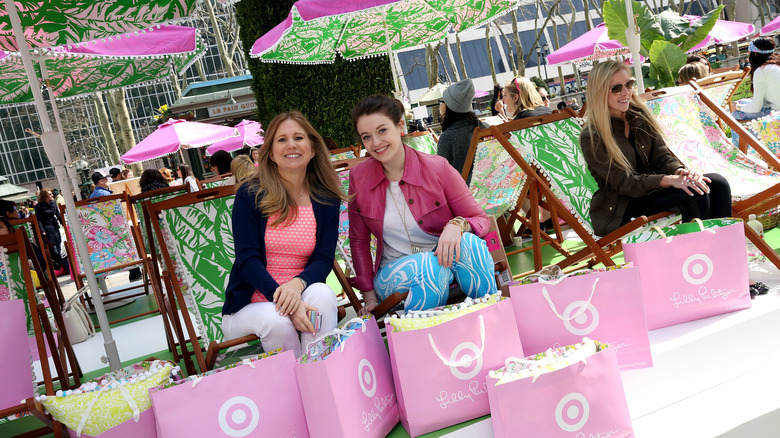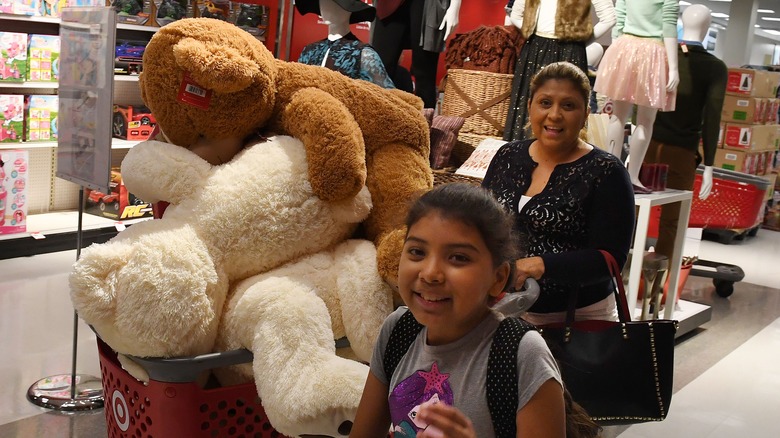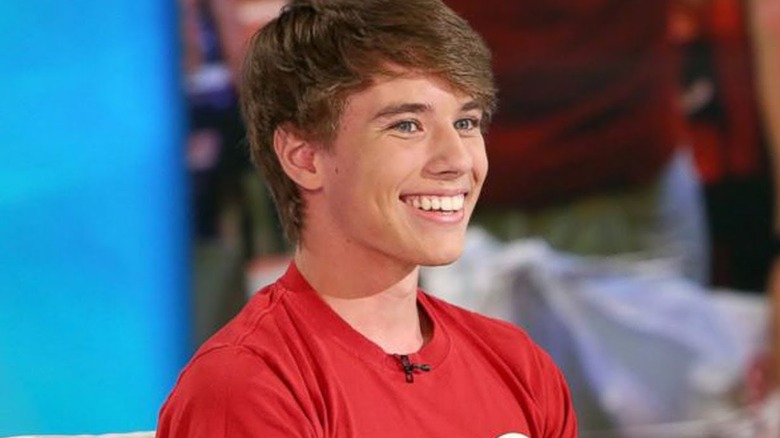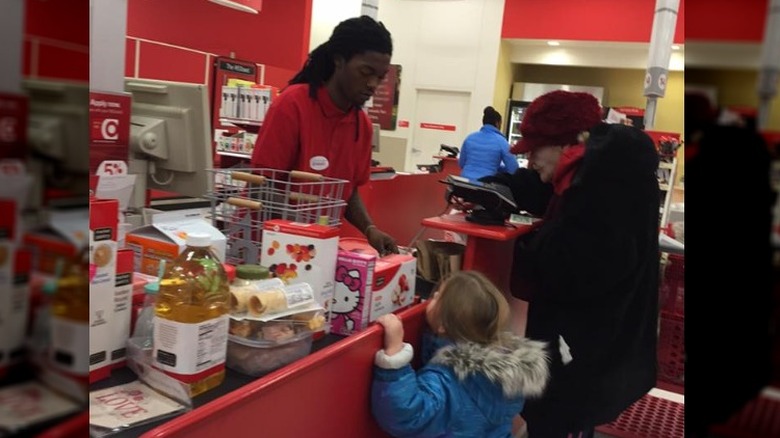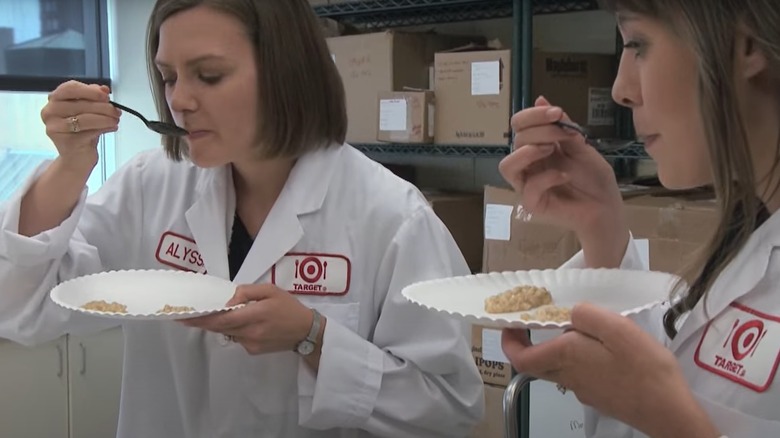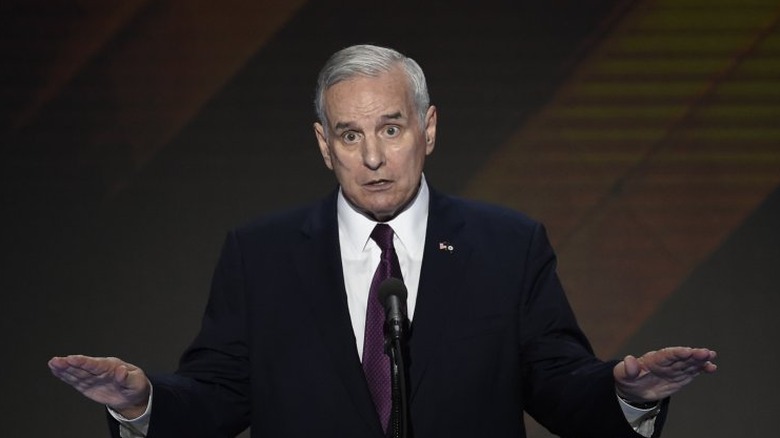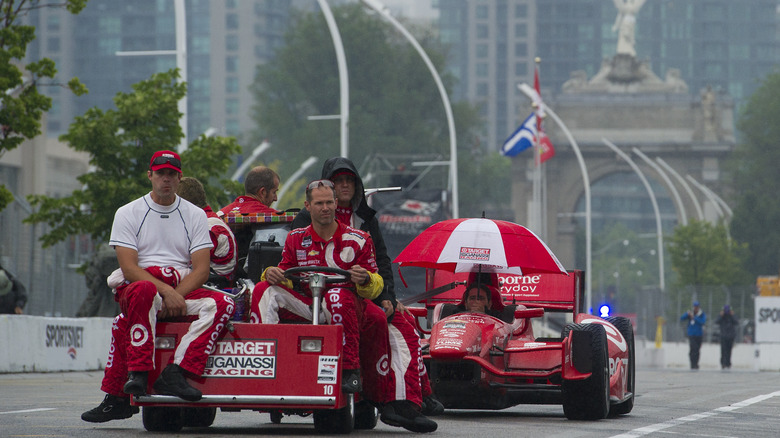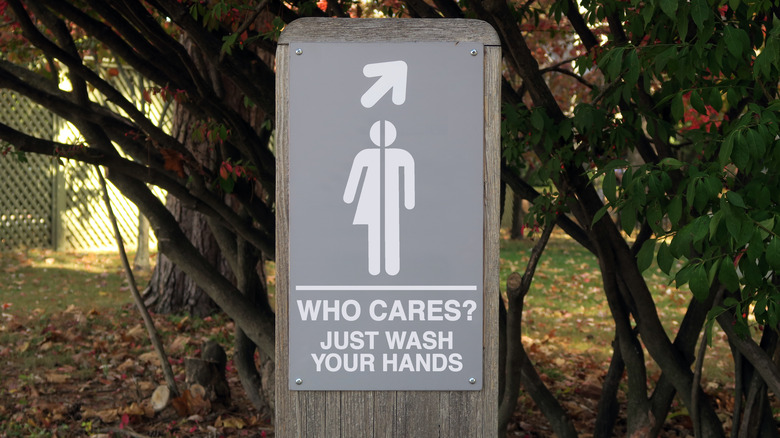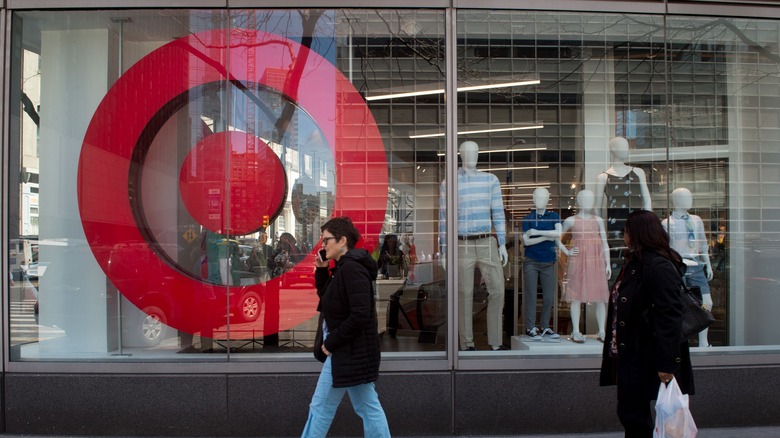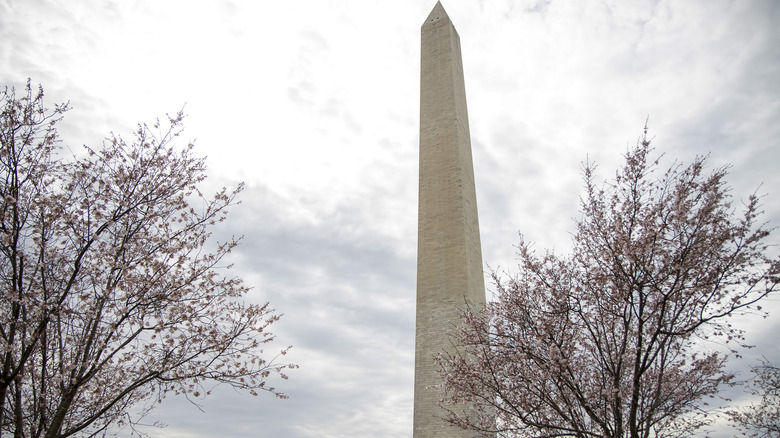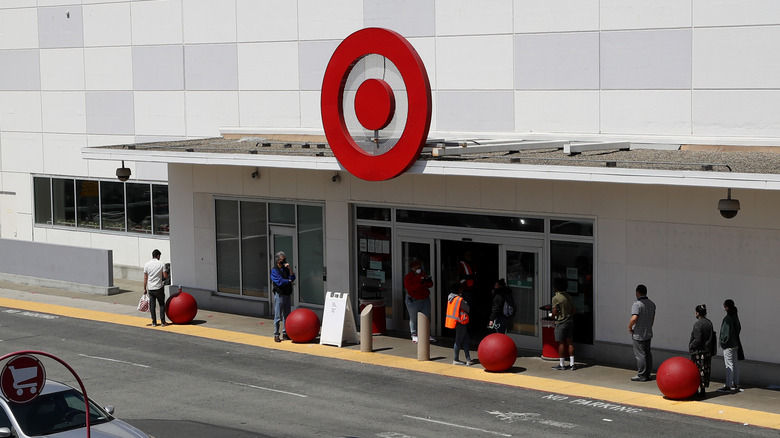The Untold Truth Of Target
We may receive a commission on purchases made from links.
Target, which is based in Minneapolis, Minn., offers one of the most pleasant big box store shopping experiences out there. With its wide selection, tidy inventory, and, of course, its snack selection, Target is a popular place to shop, socialize, and fritter away hours on a Saturday afternoon. Who cares if you walk out with a bunch of stuff you totally didn't plan to purchase, thanks to the notorious Target Effect?
But there's more to know about Target than its popcorn, dollar deals, and bountiful fast fashion selection. In fact, Target has grown and evolved considerably in the more than 50 years its cheery red doors have been open. Did you know it wasn't always called Target, for example? And why was their expansion into Canada a total flop? Plus, what's the deal with that teen pregnancy story?
So whether you're a longtime fan of the hippest big box store or just getting to know the lay of Bullseye's land, read on to discover the untold truth of Target.
People have called Target Tarjay since the 1960s
Many Target shoppers have made the joke of using a French pronunciation for the store's name to make it sound more upscale. They may think they're funny or even original in doing so. But it turns out that this French pronunciation is a very old joke. How old? Douglas J. Dayton, the first president of Target, said he first heard it in Duluth, Minn. in 1962, the year the store first opened.
Indeed the bougie pronunciation of the store has become so ubiquitous that even financial professionals use it when they're discussing business trends, according to CNBC. That was the case back in 2014, when Target was struggling to make gains in the market. "[Target] needs to get back to the 'Tarjay,' it's been awhile since we have had that perception," said Bob Drbul, equity analyst at Nomura. Sounds like this term will be in the lexicon for years to come.
Target's Bullseye is a male character played by females
Target has been using a white bull terrier as their "Bullseye" mascot since 1999. And no, they didn't find a dog that miraculously happened to have red markings on his face. Instead, they use safe vegetable-based paint to color in that bullseye. The pooch is featured on the stores' gift cards and Target has made several hundred Bullseye plush toy styles. One of the toys even made it to The Smithsonian's National Museum of American History.
In 2015, The New York Times wrote that Target picking a bull terrier as a mascot is "also a brave choice and a rare turn in the spotlight for a breed originally bred in Britain for dogfighting, a dog with the reputation of a canine gladiator that would fight to the death to please a master." But Bullseye is a friendly dog who loves to walk the red carpet and wear cool costumes, including a fire suit for auto races, and a Minnesota Twins jersey. He barks it up with celebs and even gets to travel first-class in airplanes in his own seat.
Make that her own seat. Bullseye has been portrayed by females.
The Target name and logo was one of 200 choices
George Draper Dayton was a New Yorker who wanted to get into the store business, so he chose Minneapolis, Minn. in 1881 to open the Dayton Dry Goods Company, later becoming the Dayton Company department store chain. In 1961, the company announced that they would open up a discount store offshoot, saying that the new place would "combine the best of the fashion world with the best of the discount world, a quality store with quality merchandise at discount prices, and a discount supermarket... 75 departments in all."
But they didn't know what to call it. They looked at over 200 possible choices for the name and logo, and decided that a target, complete with a bullseye logo, was the way to go. They explained the choice, saying, "As a marksman's goal is to hit the center bulls-eye, the new store would do much the same in terms of retail goods, services, commitment to the community, price, value and overall experience."
The first Target opened in 1962, and while there have been a variety of logo styles over the years, the bullseye remains front and center. It is so recognizable that reportedly 93 percent of Americans who shop can identify the brand without the store name — just the logo!
Target has a high-tech command center that scans the globe
Target's Corporate Command Center (CCC), located in Minneapolis, is where they watch what's happening at all their stores from over 75,000 feeds from digital cameras. According to Target's corporate site, it "serves as a hub and provides up-to-date information on weather conditions, natural disasters and major news world-wide, among other critical business needs."
The CCC also has partnered with the Federal Emergency Management Agency (FEMA) to be ready for any sort of disaster. For example, if a hurricane is going to hit an area, they can ship needed supplies to that region for customers to buy. That's exactly what Target did when Hurricane Irene hit the East Coast in 2012. Forget the Waffle House Index, maybe it should be the Target Index for gauging the potential impact of natural disasters.
Target collabs boost designers' popularity
Target partners with big names in fashion — like Victoria Beckham, who unveiled clothing line VBxTarget in 2017. But she's just one of many designers who have created affordable products for the stores that are a far cry from the mom jeans and sweatpants that people expect from big box stores. And unlike when Halston killed his high-fashion career by teaming up with JCPenney, teaming up with Target has only added to current designers' fame.
In 2002, Isaac Mizrahi was the first big-name designer to create lines for the store, and many have followed. Missoni, Proenza Schouler, and others have caused a shopping frenzy over the years, eliciting so much excitement that "retail scalpers" (yes, that is a thing) have made a mint reselling their clothing.
The biggest-ever collaboration? Probably Lilly Pulitzer's Palm Beach resort wear in 2015 — all of the items were snatched up in just a few hours, according to The New York Times. They've long since sold out of stores, but still pop up on eBay.
Target follows a specific markdown schedule
Target has drawn such a cult following over the years that there's even a fan site called All Things Target, letting shoppers know what's happening in the stores, and offering tips on the best deals. According to the site, the chain has a specific schedule for slashing clearance prices.
Here's the schedule: If you're looking for "electronics, accessories, kids clothing, books, baby and stationery," those prices go lower on Monday. Tuesday features "domestics, women's clothing, pets and market (food items)." For "men's clothing, health and beauty, diapers, lawn & garden items and furniture," Wednesday means further markdowns. Thursday features lower prices on "housewares, lingerie, shoes, toys, sporting goods, decor & luggage," while it's "auto, cosmetics, hardware, & jewelry" on Friday.
Remember Alex from Target?
Not only have Target products become cult favorites, but so have a few of their employees, too. Remember "Alex from Target"? Alex Lee, a teen cashier from Frisco, Texas, became a social media sensation in 2014, after a smitten girl secretly snapped a picture of him at the checkout line and posted it on Twitter.
He quickly gained millions of followers, and Crowdbabble reported on Medium that he was paid to endorse over a dozen products on social media. But there was also a downside. The New York Times noted that he received threats on his life, too.
So, what happened to Alex from Target? In the years since he rose and fell from fame, Lee has retreated from the spotlight, and he no longer works for Target. However, he did start an Instagram page devoted to fitness, which is active at the time of this writing. So if you're looking for fitness tips, he's your man!
Another Target cashier went viral for a good reason
Another viral cashier was Ishmael Gilbert. In 2016, a Target customer in a rush spotted him being extremely patient with an elderly woman who was paying for her items in change. He helped her count everything out and was very kind. Sarah Owen Bigler, the customer who posted this story on Facebook, was in the store with her young son and daughter as she watched the whole thing unfold. The woman wrote, "I realized I hadn't been inconvenienced at all. That my daughter was instead witnessing kindness and patience and being taught this valuable lesson by a complete stranger; furthermore, I realized that I too needed a refresher on this lesson."
Gilbert's great customer service became a national story. Then later on that year, according to SuperSoul.tv (via HuffPost), a manager at a local kidney dialysis center later spotted him in action and offered him a job at Fresenius Medical Care. HuffPost said he is currently employed there "as a patient care technician and is working toward becoming a certified hemodialysis technician," and that "the center is also paying for his education as he studies to become a registered nurse."
Target has a test kitchen
Many retail food companies and chain restaurants have test kitchens, and so does Target. Since they have in-house food brands like Archer Farms and Market Pantry, they test all the recipes first before producing them. They even host a Cake Week multiple times a year.
One of the food kitchen experts in the Target Test Kitchen explained their philosophy. "We're designers, but in the food world," she said in a promotional video. "Food is chemistry so we're working with these ingredients and making sure they go together." But unlike a chemistry class, these experiments usually have a delicious ending.
In addition to making sure that things taste good, Target's food scientists also believe in keeping costs down. "If it's not affordable at a price that she wants it, it's never going to go off the shelf," another expert shared. It sounds like they have their work cut out for themselves!
That teen pregnancy story may have been bogus
In 2012, The New York Times claimed that an anonymous pregnant teenage girl's father discovered her pregnancy via targeted store coupons. But that may not have been the real story.
Charles Duhigg, the author of the piece, talked to Eric Siegel, who later authored the book Predictive Analytics: The Power to Predict Who Will Click, Buy, Lie, or Die. Siegel directed Duhigg to a talk Eric Pole gave about Target's predictive analytics that Siegel witnessed. The speech reportedly did not include the teenager anecdote, but the article did, "with the unsubstantiated but tacit implication that this resulted specifically from Target's PA project," Siegel wrote in his book. He also noted that the anonymous anecdote helped launch Duhigg's book, The Power of Habit: Why We Do What We Do in Life and Business, which hit The New York Times best seller list.
However, Siegel said in his book that the top way Target found out if a customer was pregnant wasn't from their shopping habits, but from them signing up for a baby registry at the store. What's more, analytics writer Gregory Piatetsky asked Siegel if the "predictive analytics" Target used "really [identified] and [revealed] a teen pregnancy," and Siegel said "that very likely this was NOT the case," Piatetsky wrote.
Minnesota's former governor has a big Target connection
When Dayton family patriarch George Draper Dayton first went into business over a century ago, he started with a single building in downtown Minneapolis, as noted by the Minn Post. However, all these years later, the Dayton family is worth a whopping $1.6 billion, according to Forbes in 2015. There's a good chance that the late Target founder would be quite pleased with his family's success were he here to see it!
Not every Dayton descendant worked exclusively in the retail sector though, as one of them held a seriously coveted political office. That would be former Minnesota governor Mark Dayton, who held the office from 2011 through 2019, stepping down when he chose not to run for a third term. That was on the heels of his tenure as a senator of Minnesota, a job he had from 2001 to 2006, as noted by Twin Cities.
Target's Canadian debut was a flop
As much as Americans love Target, Canadians weren't feeling it. Target spent $7 billion and two years there, only to see it completely fail. CEO Brian Cornell said, "In my time here at Target, I've developed a better understanding of just how deeply our entry disappointed Canadian shoppers," who were reportedly initially excited about the stores, thanks to visiting them in the U.S.
Part of the problem was that Target took over the leases of Zeller's, a defunct chain, instead of building the stores from the ground up. Fortune pointed out that "most Zeller's stores were dumpy, poorly configured for Target's big-box layout, and were in areas not frequented by the middle class customers Target covets," saying that "inheriting many awful locations from a dying low-end retailer was at the heart of the damage to Target's cheap-chic allure in Canada."
In addition, Slate said that because the chain "revved up so quickly, the company never had time to develop a working supply chain in Canada, which left its stores short on merchandise and full of empty shelves."
Target's transgender policy was progressive, but hurt them financially
In April 2016, when the subject of transgender people using the restrooms of their choosing was abuzz, Target posted, "We welcome transgender team members and guests to use the restroom or fitting room facility that corresponds with their gender identity." But customers who weren't on board with that decided to boycott the stores.
It was a move that made a dent in Target's bottom line, especially in the South. The Wall Street Journal reported in April 2017, one year later, that "inside the company, executives predicted the backlash would die down. It didn't, and foot traffic in several markets, particularly in the South, declined considerably in the months following the announcement."
The article noted that some of the stores seeing declining sales were near Walmarts, and "were physically worn down and weren't competitive on prices of commodity goods." Since that time, Target promised to "invest $7 billion" in part to upgrade and "remodel 110 stores [in 2017], one-third of those in the Dallas-Fort Worth area — a market that lost foot traffic after the bathroom pronouncement." In addition, Target said they would spend $20 million to add private bathrooms to stores that didn't already have them.
Target's breastfeeding policy is pretty progressive
In 2015, Target found itself on the receiving end of a lot of love from breastfeeding parents. That's because their breastfeeding policy, which is arguably quite progressive, was posted by a user in a Facebook group for nursing moms — and went viral after being shared by another. Notably, the policy says parents can breastfeed anywhere they need to in the store, and should be left alone when they are doing so. Also, if asked, the fitting room should be offered for a more private option, and not the restroom.
Plenty of folks were happy to see this, and they gave kudos to Target for being so forward-thinking. "We want all of our guests to feel comfortable shopping with us," the company told Today. "Our breastfeeding policy, which applies to all stores, is just one of the ways in which we support our guests."
That's a long way away from where the retailer found itself in 2011, when a group of breastfeeding mothers staged a sit-in to protest how one mother was treated at a Target in Texas.
Target helped save this historic monument
Target may be headquartered in Minnesota, but when a famous monument in Washington, D.C. was in need of repair, the retailer didn't hesitate to open its wallets. In fact, Target forked over a million dollars to help maintain the Washington Monument back in 1997, and helped to raise an additional $4 million on top of that. That essentially made them partners with the National Park Service and the National Park Foundation.
Part of the money was used to hire an architect who would ensure that the monument was recognizable during construction, said Stephen Lorenzetti, the Park Service's regional resources manager. "Most scaffolding we've done in the past has been strictly functional," he explained in an interview with The Baltimore Sun. "The thinking at Target has been that since the monument was going to be covered up, they wanted it to be a little interesting, a little more than a cultural icon hidden from view." Well done, Target!
What's the deal with the large red spheres outside of Target?
If you're a regular Target shopper, you've probably become accustomed to the large, red spheres that sit outside of the entrance and exit doors. But if you thought they were simply an aesthetic choice, perhaps to complement the crimson Target logo, you'd be wrong. According to an article published on MSN, those large spheres are called bollards, and they serve a specific purpose: to prevent drivers from ramming their cars into the entrance and potentially causing injury to shoppers. Who knew they were so practical?
As well-intentioned as the large scarlet orbs may be, they have attracted their fair share of controversy on more than one occasion. For one, in 2016, one mother sued the retailer when her 5-year-old child severely injured his elbow after falling off of a bollard. Then, a year later, another woman filed suit when her car was hit by a bollard that had become unmoored. Yikes!
